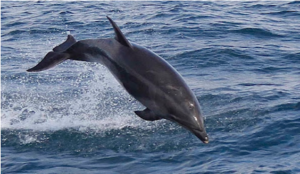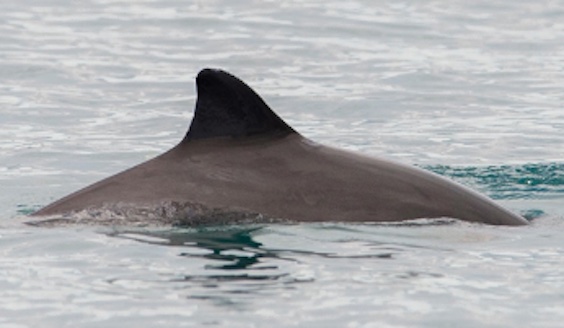Cetaceans (Whales, Dolphins and Porpoises)
Click on a picture below to jump directly to that Cetaceans information
Common Dolphins
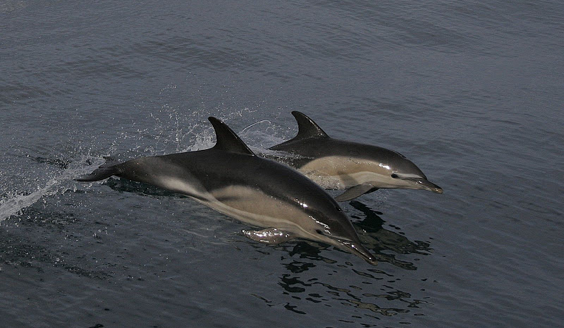
Common Dolphins are widespread throughout our oceans, and are usually 2.1 metres (feet) long with a maximum of 2.6 metres (8.5 feet), the weight averages from 86 kgs (180 lb), with a maximum of 136 kg (300 lb). Common Dolphins are sleek, streamlined and spindle-shaped, with a long beak and pointed flippers. They usually mate in the summer months with a gestation period lasting 10 to 11 months. Calves are born in the summer, and the interval between calves can be as short as 16 months, therefore two calves every 3 years. Many thousands of Dolphins are taken as a by-catch in large purse-seine nets. They have long supported extensive whaling industries to the Black Sea and on the coast of Japan. At one time, 130,000 Common Dolphins a year were being taken in the Black Sea alone. Japan and the Faeroe Islands also kill many thousands every year with many more being trapped in nets in nearby France. Common Dolphins are known to travel along above submarine ridges, diving down through the deep scattering layers of plankton to feed on Lantern fish and squid. Common Dolphins are found worldwide in a tropical and temperate waters, both coastal and deep water, though concentrations are usually greatest over shallow banks. They come readily to bows of ships, the thin sickle shaped fin and quicker movement through the water distinguishes The Common Dolphin from its cousin the Bottle-nose Dolphin. There are numerous, well-founded reports of group members coming to aid weak or wounded individuals. Aristotle saw one support the body of a dead calf. A recent expedition in the Mediterranean saw a stunned animal being supported constantly by others, taking turns 2 or 3 at a time, to hold it up to the surface until it recovered and was able to join them as they swam away. In the light of observations such as these classical myths like the tale of the lyric poet Arion of Lesbos being carried to safety on the back of a Dolphin no longer seem absurd.
Bottlenose Dolphins

Bottle-nose Dolphins are widespread throughout the worlds oceans, they are a medium sized animal where the length averages about 3 metres (10 feet) but the larger males can reach a maximum of 4.2 metres (14 feet) in length. The calves are about 1 metre in length at birth, and weight at 70 pounds at birth, the adults weigh in at 440 lb for females and to 1,430 lb for males. The calving interval is every 2 years and each Bottlenose female can expect to have 8 calves in her lifetime. Some adults weigh almostas much as Pilot Whales. The bottle-nose Dolphin is a heavier with a broader fin than the Common Dolphin. The Bottle-nose Dolphins readily bow-ride ships, and readily enjoy the company of man. they eat about 15 lb to 33 lb of fish every day. They feed largely on bottom dwelling fish such as Eels, catfish, sharks, rays. Bottle-nose Dolphins live for 25-30 years, usually maturing when 6 years old, and the gestation is 12 months, the calves are usually born in spring and summer. Although the Bottlenose Dolphins are still fairly common, there has been a great reduction in stocks due largely to pollution, but in many cases are still hunted with guns and harpoons. In West Africa, the Caribbean and Japan small numbers are taken each year in coastal operations promted by fearof competition for dwindling fish stocks. In many area a direct and recent threat to the species is posed by the numbers being captured and taken alive for displays.
Risso’s Dolphin (Grey Dolphin)
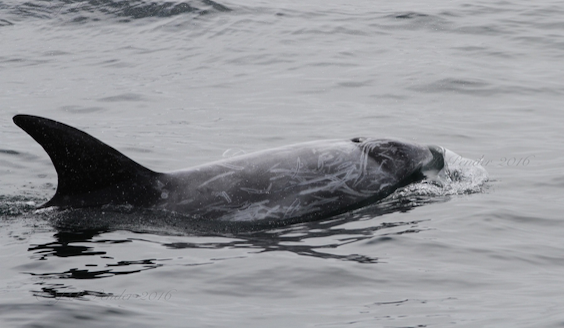
The report of the Nice stranding came from an amateur naturalist known to to history simply asM. Risso, but Cuvierreferred to the animal sevral times as dauphin de Risso and this became not only the vernacular name, but was adopted scientifically by several later authors. The Risso’s Dolphins length averages 3 metres (10 feet) with a maximum of 4.25 metres (14 feet) in length. The calves are about 1.5 metres (5 feet) at birth, with calving taking place between June and August The weight ave.rages 300 kgs (660 lbs) with a maximum of 680m kgs (1,500 lbs). The body shape is very reminiscent of Pilot Whales robust in front of the fin and tapering rapidly to a narrow tailstock behind it. These dolphins are a pale grey colour with the adult bulls having a white head, and the older the bull the more extensive white there is on the head along to the dorsal fin. The white head of the males is produced by extensive scarring when sparring with other male Risso’s Dolphins when in the act of courtship looking for a mate. The main diet of the Risso’s Dolphins is Squid. The Risso’s Dolphins have the largest Dorsal fin next to the Killer Whales, and when at sea the large dorsal fin of the males are often mistaken for that of the Killer Whales.
Atlantic White-Sided Dolphin
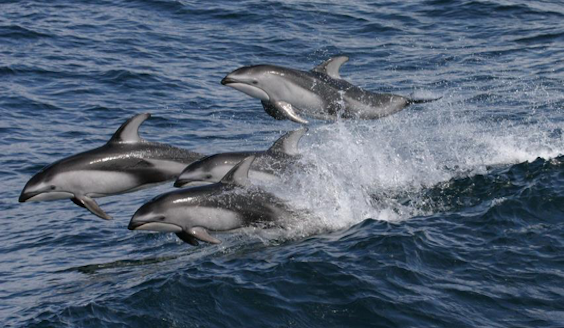
This is a very scarce Dolphin in the South West waters and only encountered in ourwaters or in strandings. White-sided Dolphins average length is 2.4 metres (8 feet) with a maximum of 3 metres (10 feet): calves are about 1.05 metres (3.5 feet) at birth. Weight averages 190 kgs (420 lbs), with a maximum of 250 kgs (550 lbs): calves are about 34 kgs (75 lbs) at birth. This is the second largest species in the genus it is equally robust with a body strongly compressed into dorsal and ventral keels on the tailstock. Strandings of this species of dolphin are quite common. White-sided Dolphins eat both squid and fish often concentrating on the herring shoals at certain times of the year. Mating takes place in the summer. Gestation lasts for 10 months and most calves are born in April or May. These White-sided dolphins are still chased onto the shore in the Faeroe Islands where they bare ruthlessly slaughtered with Knives, spears and lances. In 2021 a total of 1,895 White-sided Dolphins were slaughtered which produced World-wide condemnation to the Faeroese Government, which has had a far reaching consequences in the Faeroe Islands tourist Indstry, with many tourist keeping clear of the islands. There is a move to possibly ban the hunting of Pilot Whales and White-sided Dolphins.
Harbour Porpoise
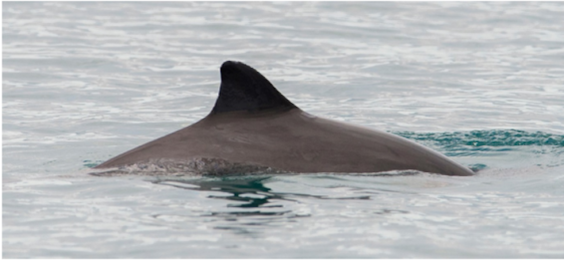
Harbour Porpoise, at one time one of the most abundant cetacean in Europe, and was the first cetacean to be called ‘porpoise’, from the Latin name pigfish, in common use in Ancient Rome. One of the few named by Linnaeus in 1758. The Harbour Porpoise, female averages 1.4 metres (4 .5 feet) in length while males average 1.8 metres (6 foot) in length, and therefore the smallest of our Cetaceans, with a maximum weight of 600 lbs , calves weigh 11 lbs at birth. there is normally no trace of a beak. Harbour Porpoises, live mainly on fish such as Herring, Whiting and Mackerel, consuming about 11 lb of fish a day. This species matures very quickly , the females being able to produce when only 14 months old, males reach maturity when 3 years old, with mating taking place in July and August, gestation lasts for 10 to 11 months, and calves nursed for another 8 months. While suckling the female rests at the surface on her side so that the calves may breathe easily. Porpoises are becoming a little less common than they were. Henry V111th of England held regular Porpoise feasts, and for centuries captured hundreds of animals each November as they made their way through the narrow straits between Funen and Jutland, before the Baltic froze over. More than 1,000 are still taken each year in Greenland and Iceland,and another 1,000 more caught in Salmon drift nets off Newfoundland. A certain number also fall foul of trawl and gill nets off the Pacific coasts of the United States and Canada. Fortunately numbers are increasing of this coastal cetacean, but it has been recently discovered that Bottlenose Dolphins kill Harbour Porpoises, and when the Bottlenose Dolphins arrive in the St. Ives Bay the harbour Porpoise quickly retreat from the Bay.
Longfin Pilot Whale

The Longfin Pilot Whales are quite rare in the St. Ives Bay and possibly at one time may have been much more common, and they are a species of whale that occurs to have mass strandings, such as 96 whales stranded at Scapa Bay on Pomona in the Orkneys. Longfin Pilot Whales vary enormously with age and sex. Calves of both sexes have a narrow head which tapers, but as they mature the head fills out and becomes square and bulbous. In adult males the melon grows into a pronounced shiny black pot shape. The average length is 6 metres (20 feet) for males with a maximum of 8.5 metres (28 feet), and 4.8 metres (16 feet) for females , with a maximum of 6 metres (20 feet):calves are about 1.8 metres (6 feet) at birth. Weight of males can be up to 3,800 kgs (4.25 tons) and of a female up to 1,800 kgs (2 tons) : calves are about 100 kgs (225 lbs) at birth. Each mature Longfin Pilot Whale, consumes about 34 kgs (75 lb) of mixed fish and squid daily. The most common food is Squid, and the most favoured fish seem to be Cod, Horse Mackerel and Turbot. Pilot Whales are found in schools of 20 to 300, with at least one report of a school of 3,000 individuals. The Faeroe hunts have been kept since 1584 and show that in the first 300 years a total of 117,456 whales were caught and killed. About 1,500 are still taken each summer in hunts, where large numbers of very fast boats herd the whales driving them onto the shore where they are ruthlessly slaughtered with knives, spears and lances. The North Atlantic populations are in serious decline because of the wholesale slaughter of these beautiful sentient beings.
Piked or Minke Whale

One of the most widespread of all whale species and a regular visitor to the St. Ives Bay particularly when the Winter Mackerel returns to the Bay. Minke Whales average about 8 metres (26 feet) for males with a maximum of 9.4 metres (31 feet), and 8.2 metres (27 feet) for females with a maximum of 10.2 metres (33 feet), the calves are 3 metres (10 feet) long at birth and weigh in about a tonne in weight. The weight averages, 5,800 kgs (6 to 8 tons ) for both sexes with a maximum of over 9,000 kgs (10 tons). The Minke Whale is the smallest Rorqual, less streamlined, more chunky than its relatives. Minke Whales belongs to the Baleanoptera group of whales that have baleen plates composes of Katin in their mouths used for sifting small fish and krill, the baleen plates number about 260-360, and normally about 300 mm (12 inches ) in length. They have broad white bands on the flippers which show up well when observed from above or in very crystal clear seas. They travel at 24-30 kph (13 to 16 knots,) even at this speed they can dive down beneath the hull and surface again on the other side without losing ground. They have been known to keep pace with a ship travelling at 24 to 30 miles an hour. Minke Whales are known to feed more on fish than plankton, the reason why they are following the mackerel Bonanza in the St. Ives Bay. The world total population for this species is about 200,000. After
prolonged exploitation in the northern hemisphere, Piked Whales are now present in small numbers. Piked Whales live for about 50 years, reaching sexual maturity at about 6 years old when males are 7 metres (23 feet) and females approximately 7.6 metres (25 feet) in length, females ovulate twice a year in the Northern Hemisphere in February and August. Gestation lasts for10—11 months and the calves are suckled for a further 6—9 months, making it possible for these whales to breed every 18 months, faster than any other Mysticene.
Humpback Whale

The Humpback Whale is an annual visitor to the St. Ives Bay since January 2013 when the very first Mackeral Bonanza arrived in the St. Ives Bay, where on occasions there have two or more Humpbacks in the Bay. There was a single record many years before that of a young Humpback whale that got itself entangled on the Stones Buoy but sadly died. The Humpback Whale is very large with an average length 14.6 metres (48 feet) for males with a maximum of 17.5 metres (58 feet), and 15.2 metres (50 feet) for females, with a maximum of 19 metres (62 feet): calves are about 4.5 metres (15 feet) at birth. The weight averages 30,000—40,000 kg (34—45 tons) for both sexes, with a maximum of 48,000kg (53 tons), calves are about 1,300 kg (1.5 tons) at birth. Although Humpback Whales are classified in the family Balaenopteridae, they are unlike the Rorquals. The body is probust, narrowing rapidly in front of the huge tail flukesThe head is broad and rounded, in some ways like that o the Blue Whale. The most characteristics features are the enormous flippers. They are almost a third of total body length (about 5 metres or 16 feet long in an adult) and heavily scalloped on the leading edge. The trailing edge of the tail flukes is similarly serrated. The rough knobbly skin provides great scope for ectoparasites. Humpbacks in cold wates are infested with up to 450 kg (half a ton) of the Sessile Barnacles. A long necked Goose barnacle which never paratises the whale directly often sits on top of the barnacles. Humpbacks mature in less than 10 years, when males are 11 metres (36 feet), and females 12 metres (40 feet) long Mating takes place on communal breeding grounds in warmer waters, usually in shallow bays. Gestation lasts for 11—12 months and the calves nurse until they are a year old and 8 metres (26 feet). During this time it is common to see a mother and her calf together with a third whale, a mysterious escort, who is sometimes an adult male, which happened when the first Humpback appeared in the St. Ives Bay. New mating frequently takes place soon after birth, so Humpbacks can breed every other year. Humback Whales are known for their longest and most varied songs in the animal world where they can be heard through the hulls of the ships
Fin Whale
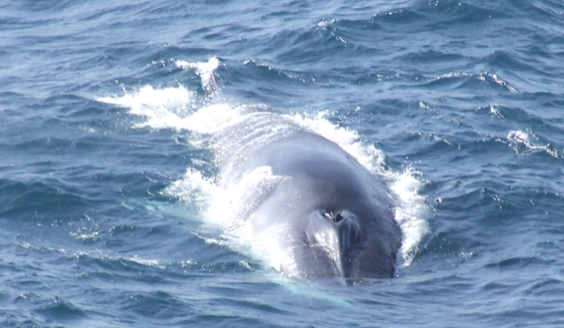
The Fin Whale is a very rare whale in the St. Ives bay where an adult female arrived in the Bay with her well grown young, but sightings have occurred from the NCI Station well out at sea.The length of the Fin Whale averages at 21 metres (71 feet) for males, with a maximum of about 25 metres (82 feet), and 22 metres (73 feet) for females, with a maximum of about 26.8 metres (88 feet); calves are about 6.5 metres (22 feet) at birth. Weight averages 35,000—45,000 kg (40—50 tons) for both sexes, with a reported maximum of over 69,500 kgs (76 tons); calves are about 3, 600 kgs (4 tons) at birth.Fin Whales are second only to Blue Whales in length and weight. They are perhaps the fastest of the great whales, being aero dynamic in structure with a wedge-shaped head with the small fin, about 600 mm (2 feet) high, placed about 62% long the back of the animal, that gave the whale it name. The first indication of a Fin Whale in the vicinity is the huge blow 4—6 metres high (13—20 feet) the height of a two storey house, that can be seen many miles away. Fin whales are generalised feeders mainly on Krill in Antarctica, and Sardines off the Aleutian Islands, and Pollack off Alaska, off Kamchatka the Copepod, around the Kuriles it s Squid, off the California coast Anchovies and Newfoundland it is Capelin. The age of maturity has been depressed by whaling to about 6 years for males (at 17 metres or 57 feet long), and 7 yeats for females (18 metres or 60 feet long). Mating occurs in winter in warmer waters, gestation lasts a year and so the young tend to be born in the same area the following year. Suckling lasts for 6 months when the calf doubles its length to 12 metres (40 feet). Females calve in alternate years, Fin Whales live for 100 years and travel 20,000 km (12,000 miles) a year to and from tropical waters. Sadly Japan started to hunt Fin Whales in the southern ocean for scientific purposes, which fortunately has now closed down. This year Iceland, (2022) started whaling hunting the Fin Whale where at the end of the season had slaughtered 125 Fin Whales, who are still in the IUCN Red Data book. There had been a huge response to the Icelanic whaling with the worlds media involved, having followed the Whalers
Killer Whale (Orca)
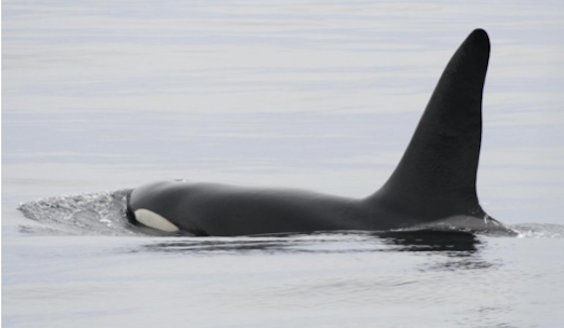
Having observed, recorded, and documented seabird migration for the last 68 years. I have only ever had two pods of Killer Whales that were passing by the St. Ives NCI Station going Westwards that was the only British Pod, on passage to the Bay of Biscay. Sdaly this pod eventually died out due to P.C.B’s. Killer Whales length averages 8 metres (27 feet) for males, with a maximum of 9.75 metres (32 Feet), and 7 metres (23 feet) for females, with a maximum of 8.5 metres (28 feet); calves are 2–2.4 metres (8 feet) at birth. Weight can be up to 7,200 kg (8 tons), usually 700kg/m for males, and 500 kg/m for females. This is a heavy-bodied whale, with a blunt round head,smooth streamlining, a 2 metre (6 foot tall fin), and unusually large (20 per cent of body length) paddle shaped flippers. Killer Whales are capable of travelling at 50 kph, (27 Knots). Killer Whales are top predators in the ocean consuming a wide variety of prey such as Squid, Bony fish, Skates, Rays, Sharks, Seals, Sea Lions, Sea birds, Walrus. KillerWhales also eat other whales such as Common Porpoise, Spray Porpoise, Belugas (White Whales) Minke Whales and Grey Whale calves, as well as Fin whale calves. Killer Whales ave a particularly fondness for the tongues of large baleen whales, ripping them ou from the carcasses that have been inflated by the whalers, or even attacking live Great Whales with similar intent. Killerv whales consume 45 kgs (100 lb) of fish a day,but their appetites are enormous. Eschricht claimed to have found 13 Porpoises and 14 seals in the stomach of an adult male with a seal half eaten in its mouth. Little is known about the reproductive behaviour of Killer Whales. Gestation lasts for 12 months. Calves are born in shallow water in autumn or early winter. Males reach maturity at a length of 6 metres (20 feet) and females at about 5 metres (16 feet). A lucrative and growing trade involving he capture of the killer whales for displays has recently come under control, at least in Canadian and American coastal waters.

